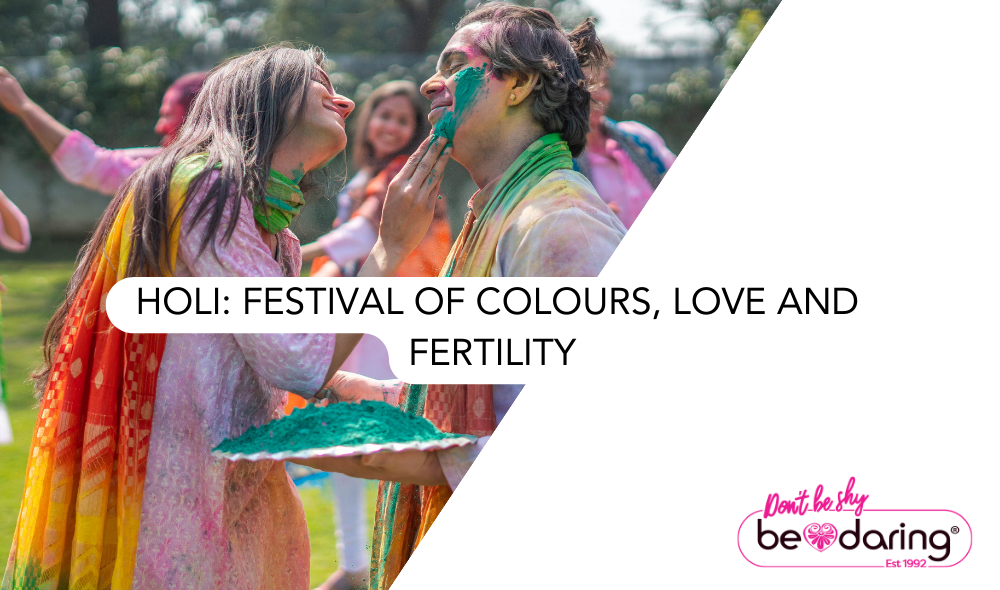HOLI: FESTIVAL OF COLOURS, LOVE AND FERTILITY

Unbeknownst to many, the Holi holiday commemorates India's ancient Valentine's Day. Holi, also known as the Festival of Colour, is a Hindu festival that began in India but is now celebrated around the world. The festival calendar dates vary from year to year because they are based on the lunar calendar. It begins on the night of the full moon in the Hindu month of Phalguna. This year's Holi celebrations began on March 24, 2024. Celebrations for Holika Dahan may begin the day before with a bonfire, depending on regional traditions.
It is said that Lord Shiva burned Kaamadeva on Holi.
People in the south adore Kaamadeva, the Love God, for his extraordinary sacrifice on Holi. Kaamadeva is represented with a sugarcane bow with a string of buzzing bees and arrow shafts capped with passion that pierce the heart. The deity is given mango blossoms, which he adored, and sandalwood paste to alleviate the pain of his deadly burns.
In Tamil Nadu, Holi is known by three names: Kamavilas, Kaman Pandigai, and Kama-Dahanam. The struggle began when Goddess Sati, the daughter of Daksha Prajapati, one of Lord Brahma's first sons, wedded Lord Shiva, despite her father's wishes. When she came, she realised her mistake and was furious at her husband's remark. As retribution for her transgression, she entered the fire and died. When Lord Shiva learned of her death, he was outraged. After regulating his wrath, he chose to meditate and abstain from all worldly worries. Without him, the world's balance quickly slipped out of sync. Sati then reincarnated as Goddess Parvati in an attempt to win Lord Shiva's affection and awaken him from his stupor. When she had exhausted all of her feminine options, she requested the assistance of Kamadava (the Indian cupid-god) in shooting his love-arrow into Shiva's heart.
This successfully roused Lord Shiva, but he was so enraged that he opened his third eye and immediately burned Kamadeva to ashes. It is stated that Holi was the day Kamadeva sacrificed himself for the benefit of all beings. However, his efforts were successful, and Lord Shiva wedded the Goddess Parvati soon after. Later, Lord Shiva realised his error, he granted Kamadeva immortality in invisible form.
Lord Kama The cupid of Hindu mythology! Today we will go through Teachings of Love from Sanatan Dharma also known as Hinduism
What is love? Is it a transitory emotion or something deeper? Is it under our control, or does it control us?
Sanatan Dharma, one of the world's oldest faiths, gives an answer for each of these questions. It tells us that love is the basis of all existence. It is the power that unites us as a human family. It is the wellspring of all joy, tranquilly, and happiness. But what does it mean to claim that love is the essence of all existence? It indicates we're all made of love. It implies that love is the basic foundation of reality. It means that love connects us to one another and to God. Sanatan Dharma teaches us that love is more than just a feeling. It's a manner of being. It is the way we live our life. It is a method of interacting with the environment around us.
Allow me to comprehend or break things down for you so that you have a better understanding of it. These are the five laws or pillars of love in Sanatan Dharma:
Kama/sensory desire.
It represents attraction to the beloved and sexual desire. This is the stage at which we are pulled to someone's physical appearance and develop a strong sexual desire for them. Kama (sex) was one of three life goals, along with Dharma (religion) and Artha (money), for a healthy and happy existence.
Even in the Bhagavat Gita, Lord Krishna asserts that he exists in the human body as sexual desire. In ancient India, sex was seen as the foundation of a virtuous society as evidenced by the wonderfully crafted sexual sculptures on the temple walls.
Shringara
Shringara is the second stage of love, defined by romantic and emotional intimacy. This is the stage at which we begin to develop stronger sentiments for our partner and express our thoughts, feelings, and desires to them. Sringara Rasa is associated with pleasant seasons, garlands, ornaments, enjoying the company of loved ones, music and poetry, and going to the garden and walking around. It should be expressed on stage with calm eyes and a smiling smile, lovely words of contentment and delight, and delicate limb movements."
Maitri
Maitri is the third stage of love, defined by unselfish love and compassion. This is the point at which we start to perceive our partner as more than just a love partner, but also a friend and confidant. We care deeply for them and want them to be happy.
Lo, verily, not for love of a husband is a husband dear, but for the love of the Self a husband is dear.
Not for the love of the wife is a wife dear, but for love of the Self a wife is dear.
— Brihadaranyaka Upanishad 2.4.2–4
Bhakti
Bhakti is the fourth stage of love, defined by devotion and surrender. This is the stage at which we develop a strong spiritual connection with our companion. We regard them as a reflection of the divine and feel unified with them.
Atma-Prema
Atma-Prema is the fifth and last stage of love, defined by unconditional self-love. This is the stage at which we have gained a thorough awareness of ourselves and our partner. We love them for who they are, imperfections included. We also love ourselves unconditionally and may offer and receive love without expectations.
Here are some of the teachings that we can take from Sanatan Dharma for a good love relationship:
Love is a sacred bond. In Sanatan Dharma, marriage is seen as a sacred union between two souls. It is a bond that will endure a lifetime.
Love is built on mutual respect and understanding. A good love relationship requires both partners to respect and understand each other's wants and desires. They should be able to properly converse with one another.
Love is forgiving. Everyone make mistakes. In a good romantic relationship, both partners must be able to forgive each other for their errors.
Love is unselfish. In a good love relationship, both partners should be prepared to prioritise the needs of the other person over their own.
Love is patient. Love need time to grow and flourish. A good love relationship requires both partners to be patient with one other and allow their love to flourish.
Here are some particular examples of how the teachings of Sanatan Dharma might aid us in our romantic lives:
The notion of Dharma: Dharma, a Sanskrit word, denotes "righteous duty." In Sanatan Dharma, each person has a distinct dharma that they are destined to fulfil in life. Our dharma encompasses our connections. When we live in accordance with our dharma, our relationships are more likely to be healthy and rewarding.
Yoga is a mind-body activity that can help us cultivate self-awareness, compassion, and self-love. These characteristics are needed for a healthy romantic connection.
The notion of Ardhanarishvara: Ardhanarishvara is a composite god who represents Shiva and Shakti, the universe's masculine and feminine aspects. Ardhanarishvara teaches us that love involves balance and harmony. It is about combining the various aspects of ourselves and our partners to form a whole.
In ancient Hindu philosophy, love is viewed as both a personal experience and a spiritual path. The road of love is about self-discovery and growth. As we progress through the stages of love, we discover more about ourselves and what it means to love and be loved.
In a society when love is frequently viewed as a commodity, it is more critical than ever to understand the genuine meaning of love. Sanatan Dharma can help us achieve exactly that.
















